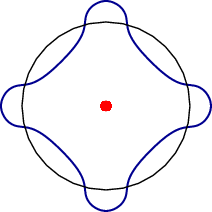
The classical picture of the hydrogen atom is planetary in nature: an electron moves in an Kepler orbit around the proton. The problem is that there is a force acting on the electron, and accelerated charges radiate (that is what a radio is based on). This allows the atom to loose energy in a continuous way, slowly spiraling down until the electron lies on the proton. Now experiment show that this is not the case: There are a discrete set of lines in the light emitted by hydrogen, and the electron will never loose all its energy. The first explanation for this fact came from Niels Bohr, in the so-called old quantum theory, where one assumes that motion is quantised, and only certain orbits can occur. In this model the energy of the Balmer series of Hydrogen is given by
|
{E}_{n} = −{\left ( {{e}^{2}\over
4π{ϵ}_{0}}\right )}^{2}{2{π}^{2}me\over
{h}^{2}} {1\over {
n}^{2}}.
| (1.6) |
Clearly this is of quantum origin again.
